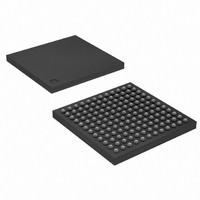AT91SAM9R64-CU-999 Atmel, AT91SAM9R64-CU-999 Datasheet - Page 658

AT91SAM9R64-CU-999
Manufacturer Part Number
AT91SAM9R64-CU-999
Description
IC MCU ARM9 64K SRAM 144LFBGA
Manufacturer
Atmel
Series
AT91SAMr
Datasheet
1.AT91SAM9R64-CU.pdf
(903 pages)
Specifications of AT91SAM9R64-CU-999
Core Processor
ARM9
Core Size
16/32-Bit
Speed
240MHz
Connectivity
EBI/EMI, I²C, MMC, SPI, SSC, UART/USART, USB
Peripherals
AC'97, POR, PWM, WDT
Number Of I /o
49
Program Memory Size
32KB (32K x 8)
Program Memory Type
ROM
Ram Size
72K x 8
Voltage - Supply (vcc/vdd)
1.08 V ~ 1.32 V
Data Converters
A/D 3x10b
Oscillator Type
Internal
Operating Temperature
-40°C ~ 85°C
Package / Case
144-LFBGA
Processor Series
AT91SAMx
Core
ARM926EJ-S
Data Bus Width
32 bit
Data Ram Size
64 KB
Interface Type
SPI, TWI, UART
Maximum Clock Frequency
240 MHz
Number Of Programmable I/os
118
Operating Supply Voltage
1.65 V to 3.6 V
Maximum Operating Temperature
+ 85 C
Mounting Style
SMD/SMT
3rd Party Development Tools
JTRACE-ARM-2M, MDK-ARM, RL-ARM, ULINK2
Development Tools By Supplier
AT91SAM-ICE, AT91-ISP, AT91SAM9RL-EK
Minimum Operating Temperature
- 40 C
For Use With
AT91SAM-ICE - EMULATOR FOR AT91 ARM7/ARM9
Lead Free Status / RoHS Status
Lead free / RoHS Compliant
Eeprom Size
-
Lead Free Status / Rohs Status
Details
Available stocks
Company
Part Number
Manufacturer
Quantity
Price
- Current page: 658 of 903
- Download datasheet (13Mb)
Table 39-7.
39.5.2.6
658
Address
00
01
...
FE
FF
AT91SAM9R64/RL64 Preliminary
Intensity_bit_0
Intensity_bit_1
Intensity_bit_254
Intensity_bit_255
Dithering
Lookup Table Structure in the Memory
access is allowed (the 16 MSB of the bus are not used). For the detailed memory map, see
Table 39-13 on page
The lookup table contains 256 16-bit wide entries. The 256 entries are chosen by the program-
mer from the 2
For the structure of each LUT entry, see
In STN Monochrome, only the four most significant bits of the red value are used (16 gray
shades). In STN Color, only the four most significant bits of the blue, green and red value are
used (4096 colors).
In TFT mode, all the bits in the blue, green and red values are used (32768 colors). In this mode,
there is also a common intensity bit that can be used to double the possible colors. This bit is the
least significant bit of each color component in the LCDD interface (LCDD[18], LCDD[10],
LCDD[2]). The LCDD unused bits are tied to 0 when TFT palletized configurations are used
(LCDD[17:16], LCDD[9:8], LCDD[1:0]).
The dithering block is used to generate the shades of gray or color when the LCD Controller is
used with an STN LCD Module. It uses a time-based dithering algorithm and Frame Rate Con-
trol method.
The Frame Rate Control varies the duty cycle for which a given pixel is turned on, giving the dis-
play an appearance of multiple shades. In order to reduce the flicker noise caused by turning on
and off adjacent pixels at the same time, a time-based dithering algorithm is used to vary the
pattern of adjacent pixels every frame. This algorithm is expressed in terms of Dithering Pattern
registers (DP_i) and considers not only the pixel gray level number, but also its horizontal
coordinate.
Table 39-8
Table 39-8.
Gray Level
15
14
13
12
11
10
9
shows the correspondences between the gray levels and the duty cycle.
Blue_value_0[4:0]
Blue_value_1[4:0]
Blue_value_254[4:0]
Blue_value_255[4:0]
16
Dithering Duty Cycle
possible combinations.
677.
Data Output [15:0]
Duty Cycle
1
6/7
4/5
3/4
5/7
2/3
3/5
Table
Green_value_0[4:0]
Green_value_1[4:0]
Green_value_254[4:0]
Green_value_255[4:0]
39-7.
Pattern Register
-
DP6_7
DP4_5
DP3_4
DP5_7
DP2_3
DP3_5
Red_value_0[4:0]
Red_value_1[4:0]
Red_value_254[4:0]
Red_value_255[4:0]
6289C–ATARM–28-May-09
Related parts for AT91SAM9R64-CU-999
Image
Part Number
Description
Manufacturer
Datasheet
Request
R

Part Number:
Description:
MCU ARM9 64K SRAM 144-LFBGA
Manufacturer:
Atmel
Datasheet:

Part Number:
Description:
MCU, MPU & DSP Development Tools KICKSTART KIT FOR AT91SAM9 PLUS
Manufacturer:
IAR Systems

Part Number:
Description:
DEV KIT FOR AVR/AVR32
Manufacturer:
Atmel
Datasheet:

Part Number:
Description:
INTERVAL AND WIPE/WASH WIPER CONTROL IC WITH DELAY
Manufacturer:
ATMEL Corporation
Datasheet:

Part Number:
Description:
Low-Voltage Voice-Switched IC for Hands-Free Operation
Manufacturer:
ATMEL Corporation
Datasheet:

Part Number:
Description:
MONOLITHIC INTEGRATED FEATUREPHONE CIRCUIT
Manufacturer:
ATMEL Corporation
Datasheet:

Part Number:
Description:
AM-FM Receiver IC U4255BM-M
Manufacturer:
ATMEL Corporation
Datasheet:

Part Number:
Description:
Monolithic Integrated Feature Phone Circuit
Manufacturer:
ATMEL Corporation
Datasheet:

Part Number:
Description:
Multistandard Video-IF and Quasi Parallel Sound Processing
Manufacturer:
ATMEL Corporation
Datasheet:

Part Number:
Description:
High-performance EE PLD
Manufacturer:
ATMEL Corporation
Datasheet:

Part Number:
Description:
8-bit Flash Microcontroller
Manufacturer:
ATMEL Corporation
Datasheet:











